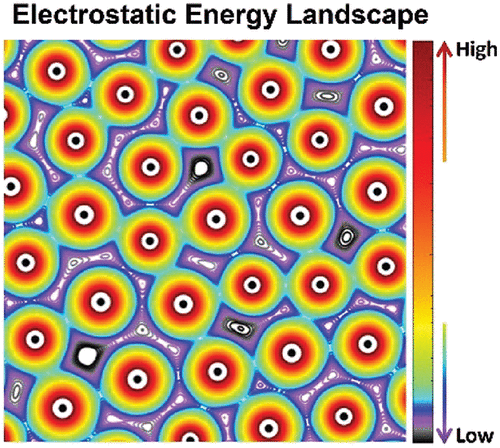当前位置:
X-MOL 学术
›
ACS Appl. Polym. Mater.
›
论文详情
Our official English website, www.x-mol.net, welcomes your
feedback! (Note: you will need to create a separate account there.)
Interpretation of Electrostatic Self-Potential Measurements Using Interface-Trapped Microspheres with Surface Heterogeneity
ACS Applied Polymer Materials ( IF 4.4 ) Pub Date : 2020-02-27 , DOI: 10.1021/acsapm.9b01189 Kyu Hwan Choi 1 , Dong Woo Kang 1 , Sunghoon Yoo 2 , Seunghyun Lee 2 , Bum Jun Park 1
ACS Applied Polymer Materials ( IF 4.4 ) Pub Date : 2020-02-27 , DOI: 10.1021/acsapm.9b01189 Kyu Hwan Choi 1 , Dong Woo Kang 1 , Sunghoon Yoo 2 , Seunghyun Lee 2 , Bum Jun Park 1
Affiliation

|
Electrostatic self-potentials of individual particles trapped at an oil–water interface were determined, and the effects of surface chemical nonuniformity on heterogeneous self-potentials and equilibrium microstructures were investigated. Direct measurement of the pair interactions and the self-potentials of polystyrene microspheres were performed using optical laser tweezers. The individual particles had different self-potentials even when they possessed the same surface functionalities. Atomic force microscopy measurements elucidated the relationship between nonuniform surface charge distribution and heterogeneity and magnitude of self-potentials. Monte Carlo simulations demonstrated that self-potential heterogeneity led to the formation of more melted microstructures that showed excellent consistency with experiments.
中文翻译:

使用具有表面异质性的界面陷阱微球对静电自电势测量的解释
确定了油-水界面处捕获的单个粒子的静电自电势,并研究了表面化学不均匀性对异质自电势和平衡微结构的影响。使用光学激光镊子直接测量聚苯乙烯微球的对相互作用和自电势。即使它们具有相同的表面功能,它们的自电位也不同。原子力显微镜测量阐明了不均匀的表面电荷分布与异质性和自电势量之间的关系。蒙特卡洛模拟表明,自势异质性导致形成更多熔融的微结构,与实验显示出极好的一致性。
更新日期:2020-02-27
中文翻译:

使用具有表面异质性的界面陷阱微球对静电自电势测量的解释
确定了油-水界面处捕获的单个粒子的静电自电势,并研究了表面化学不均匀性对异质自电势和平衡微结构的影响。使用光学激光镊子直接测量聚苯乙烯微球的对相互作用和自电势。即使它们具有相同的表面功能,它们的自电位也不同。原子力显微镜测量阐明了不均匀的表面电荷分布与异质性和自电势量之间的关系。蒙特卡洛模拟表明,自势异质性导致形成更多熔融的微结构,与实验显示出极好的一致性。









































 京公网安备 11010802027423号
京公网安备 11010802027423号